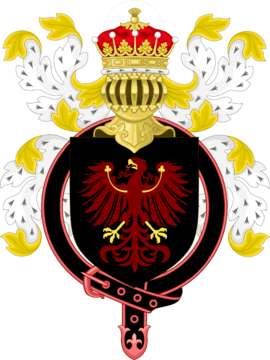Difference between revisions of "House of Suffolk"
| Line 18: | Line 18: | ||
|- | |- | ||
| <span style="font-size:small;">'''Titles''': <br> [[County of Pembrokeshire|Count of Pembroke]] <br> | | <span style="font-size:small;">'''Titles''': <br> [[County of Pembrokeshire|Count of Pembroke]] <br> | ||
| − | | | + | |- |
| + | | <span style="font-size:small;">'''Founder''': Edward I Suffolk | ||
|- | |- | ||
| <span style="font-size:small;">'''Founder''': Edward I Suffolk | | <span style="font-size:small;">'''Founder''': Edward I Suffolk | ||
Revision as of 11:20, 7 June 2019
| ||||||||||||||||
The House of Suffolk (Common: Suffolk; High Imperial: Suffolk) is the ruling family of the sovereign and independent state of the Archduchy of Suffonia . Although the family roots of Suffolk can be traced back to Vailor, the family was first ennobled in Atlas under the Kingdom of Renatus-Marna in 1661 and became independent in Arcas in the year 1718.
History
Establishment
During the times of Vailor, war caused many heartlanders to lose their families, Athelstan Suffolk from Lorraine was one of them. Athelstan, sick of the endless wars of Vailor, eager to help his fellow heartlanders, gathered a band of these refugees under his leadership and formed a nomadic tribe, seeking peaceful lands. Peace was not to be found for the followers of Athelstan and he sailed off the continent with his most loyal followers, determined to find peace, these loyal followers were to become the first Suffonians.
Athelstan who had sailed to the lands of Myth and Craft had the Savoyard culture in his heart, believing it to be the culture of nobility, but his new found refugee under the Romagnan Nation has drastically changed his understanding. For long years Suffonians cherished under Romagna and under the Romagnan culture (Latin Roman).
With the destruction of the Romagnan Nation by the Yallic and Yreek barbarians, Edward Suffolk, the current head of the Suffonians sailed off with a handful of scouts to seek a new refuge for his people.
Family During Atlas
Away from his people and his family and with the mission of finding land in his heart, Edward Suffolk, with the assistance of some new found companions, joined in to the service of Darius DeNurem, newly anointed Prince of Hanseti and Uberhoch of the Order of Judah. Edward served to House DeNurem as an Ambassador and played an important role in the Global Assembly on behalf of Hanseti. Following the dissolvement of the Global Assembly, Edward was declared as a Baron over the lands of Pembrokeshire and appointed as the Master of Wine in 1661. Edward used all his gathered wealth and constructed Pembroke Castle and established an armed force to serve House DeNurem, a fact which was rewarded with the title of Earl in 1662 by the Prince himself. On the 21st of Grand Harvest, 1663, Edward’s position was recognized by the Crown of Renatus-Marna and he was ennobled by the King as the Baron of Pembroke. With his official recognition and ever expanding number of people joining under his banners, Edward Suffolk decided to expand Pembroke as a City and started the construction of Pembroke City. Edward soon conquered all nearby keeps and built Lodmund Castle outside the city for his troops.
But growth of Pembrokeshire would abruptly stopped in 1668, when Edward Suffolk had a seizure and collapsed in his chambers while writing letters. Healers of Pembroke were not able to cure his lordship and thus Marshal of Pembroke, Henry Lodmund left all his offices behind and with his soldiers, accompanied the comatose Edward to other realms with the hope of finding a cure. Baroness Loreli was appointed as regent in the absence of Edward, but her heart gave up soon after and she was buried at Suffolk Catacombs. Privy Council convened and with the advice from letters sent by Henry, Mister Kagura Balisari, Captain of the 1st Regiment, was appointed as Regent of Pembroke. Even if Kagura was a hard worker, absence of noble administrators took its toll on Pembrokeshire and with each passing year less and less tax could be gathered. The Barony went bankrupt and most civil servants and citizens left the City for new jobs. After twelve dark years news of Edward and Henry’s return was a welcome news, but soon the joy of Suffonians turn in to ash seeing that Edward was still comatose. While abdication of the comatose Lord and declaring his eldest son and heir Richard as the new Lord was being discussed, good news came from the capital: House Suffolk’s title of Count which was never officially approved by the crown since it was bestowed upon them by Prince Darius DeNurem was now officially recognized with the Imperial letters dated 22nd of Horens Calling, 1680. And a miracle followed this, upon hearing the news, Edward opened his eyes and said to Henry Lodmund, who never would left his Lord’s side, “Dress me Henry, for we have much work to do.” News about Edward’s health were hidden from public and he recovered in secret until he declared his return at the court of 20th of the Amber Cold 1681 and started rebuilding Pembrokeshire’s glory.
Notable Figures
| Name | Portrait | Arms | Birth | Marriages | Death | Titles |
|---|---|---|---|---|---|---|
| Edward I Suffolk (Sheczar)
|
- | - | 20th of the Amber Cold, 1640
Son of Thomas Suffolk and Elizabeth Romenov |
Elizabeth Romenov (+)
Loreli Rosewell (+) |
- | Baron of Pembroke
Count of Pembroke |
| Loreli Rosewell | N/A | - | 14th of the Amber Cold, 1651
Daughter of Rosewells |
Edward I Suffolk | 1669 | Baroness of Pembroke |
| Richard Suffolk | - | N/A | 14th of the Sun’s Smile, 1659
Son of Edward I Suffolk and Elizabeth Romenov |
- | - | Heir Apparent of the County of Pembrokeshire |
